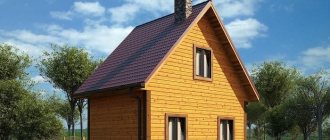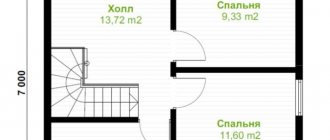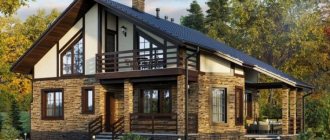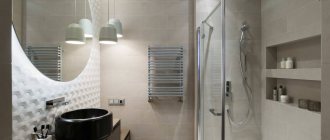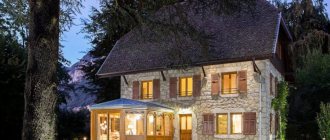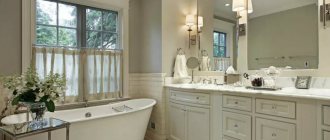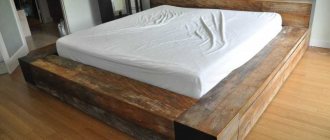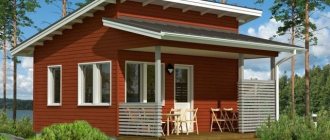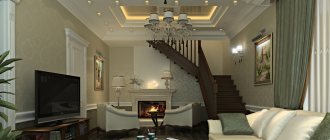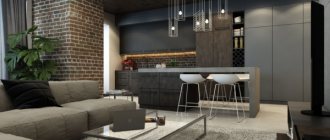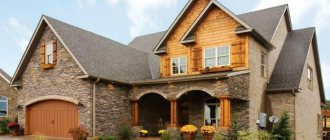Frame house construction used in Germany is one of many modern building technologies developed in this European country. It was here that the first multi-chamber double-glazed windows were designed, soft roofing material and original half-timbered structures were created.
And if you can’t find genuine half-timbered timber in almost any country, frame country cottages built using German technology are becoming increasingly popular among private developers all over the world.
This construction technology has not bypassed Russia either. Here it is valued for the ease of installation of residential buildings, reference quality construction, and energy-saving properties.
Specific Features
The specificity of the buildings is that instead of load-bearing walls they use a wooden sectional frame, and clay, brick, and stone are placed in the void between the sections. Such buildings have no more than 3 floors.
The useful space is replenished with an attic, a bay window, and an open balcony. The rectangular doors have a glass insert at the top; their color contrasts with the beige, cream, sand, terracotta, and olive plastered walls.
The window glass is divided by thin lintels. A tiled sloping or gable roof is a prerequisite; the tiles have a spectrum ranging from red-brown to dark gray. The styling is different:
- correct rectangular or square shape of the object;
- lack of an attic;
- restrained color palette;
- a small amount of decor;
- natural materials.
The outside of the home is decorated with bird houses, flower pots and special mounts for New Year's decorations; these details give it a cozy, attractive appearance. A private house in the German style is equipped with a neat, low porch. A terrace is a rare occurrence.
Great Barrier Reef
This is the world's largest natural object formed by living organisms. Off the coast of Australia there are 400 species of coral, 500 species of fish and 4,000 different shellfish. With global warming of 1.5 degrees, it could die by 2100. An increase in temperature leads to the death of algae living in polyps. Without them, corals stop growing and lose color. Half the corals have already disappeared.
Natural treasures in danger of extinction
Half-timbered buildings
This traditional branch is highlighted by wooden fixtures that divide the façade into regular segments. This characteristic technique gives the building a solid, non-standard appearance.
The design includes strong wooden posts, horizontal beams and diagonal braces, which contrast the color with the walls, thanks to which the structure has a colorful image, associated with fairy-tale houses.
The frame elements are always open, the openings are filled with building material in the form of insulation, sandwich panels. Advantages of the technique:
- Light weight, therefore, no deep foundation is required.
- Hiding communications.
- Long beams promise spaciousness to the rooms.
- There is no risk of distortion.
The disadvantages of the German style of half-timbered houses are the expensive services of specialists in design development and professional knowledge of competent installation.
Five centuries ago, such buildings were not suitable for Russian territory with a cold climate, but modern building materials, heated floors, and insulated walls provide a comfortable temperature regime in housing.
In the regions of the north, you can use the imitation option by using false blocks, or even better, polyurethane boards that are resistant to precipitation and insects, applying them to the cladding. Facade beams are placed with a certain symbolism, looking:
- X-shaped crossing of St. Andrew's cross;
- without crossing, being called "Swabian woman", resembling national dress;
- the letters Y and S, the last image according to legend gives protection from lightning.
The facades of houses in the German style are decorated with frightening faces that protect against misfortune, and a blooming flower promotes well-being. The wooden frame must be regularly treated with antiseptics to avoid damage.
Advantages and disadvantages of German frame-type houses
A frame house using German technology has many advantages. First of all, it should be noted that all construction and finishing work is carried out within 2-3 months.
Also, the advantages of German frame structures include:
- Quite attractive appearance of the buildings;
- Ecological safety for the environment;
- Ease of installation and further operation;
- Good sound insulation characteristics;
- Savings for residents on heating in winter;
- Long period of operation - at least 50 years.
But German technology also has its drawbacks:
- Assembly of structures requires high precision; any mistake can lead to serious negative consequences. Therefore, their construction must be trusted exclusively to professionals;
- Any, even the most minor, deviations from the finished project of a German frame house can result in significant additional costs for the developer.
Gothic
The Gothic movement is not difficult to recognize. It stands out with its numerous turrets, spiers, and elongated windows, comparable to medieval castles.
The roof supports are brick columns. This is just a distant copy of gloomy fortresses, which easily fits into the surrounding landscape, emphasizing the taste of the owners. Bavarian masonry is very interesting, where bricks with different shades are used, making the walls uneven in color.
A mystical atmosphere is created by lace vaults that refract the sun's rays into unique patterns. Stained glass windows add a sense of magic to the surroundings. The palette, connecting the earthly and heavenly, is enriched with white, black, blue, and dark red. The following are welcome on site:
- Beautiful lawns.
- Hedges, trimmed bushes, fruit trees.
- Flowerbeds divided into squares and connected by gravel paths.
- Alpine slide.
- Garden figures.
The old abandoned appearance of the garden will contribute to immersion in the Romanesque plot. It is planted with roses, rose hips, and ivy. Equipping one corner with mysterious stone ruins overgrown with lilies will add a zest.
Even low one-story houses in the German style, with vertical lines directed upward, look harmonious in the natural environment.
Amazon rainforest
The Amazon rainforest is the largest tropical forest in the world. They produce about 20% oxygen. These are the “lungs of the planet” and a huge natural pharmacy: here is the largest variety of plants on Earth. By burning and cutting down forests, farmers free up land for agriculture - and disrupt the ecosystem. The amount of precipitation here is already a quarter lower. Most of the forests may turn into savanna.
Natural treasures in danger of extinction
Interior decoration
Inside, wood, stone, metal, and glass are used for decoration. Wall surfaces are plastered, painted or wallpapered. There are beams on the ceiling; after whitewashing, it is not forbidden to apply gilded relief figures or paintings to it. A fireplace and forging elements are required.
Modern trends require minimalism in furnishings that do not overload the space. The furniture upholstery is made of chocolate, dark green, and burgundy fabric.
The living room has spectacular furniture with a sofa and pillows, armchairs, and a table covered with a tablecloth. A large role is given to low massive chandeliers, candelabra and candlesticks. Priority is given to chests with metal parts, carvings or stucco. The bedroom has a large canopy bed. There is a feeling of wealth, nobility and power in everything.
The multifunctional kitchen is characterized by immaculate cleanliness and polished metal utensils. For Gothic style, expensive brocade and velvet textiles are required, otherwise textiles in pastel shades made of linen and cotton. The combination of dark and light tones gives the atmosphere drama and severity.
Hallway
The amount of furniture in the hallway is minimal - a closed wardrobe, hangers and a small bench. In a spacious room, you can place a small cabinet for storing things and hang a mirror above it.
Spacious entrance hall in half-timbered style Source roomester.ru
Large and bright hallway room Source roomester.ru
For added coziness, you can add a short-pile carpet that won't accumulate dirt.
To decorate the space, you can add floor vases and decorative boxes for small items.
Bright and functional hallway Source grandk.ru
Decor
The style is not characterized by an abundance of decorative objects. Mainly:
- chic mirrors;
- canvases with landscapes;
- family photos;
- still lifes;
- busts of famous people.
Dominant position in pots with herbs. They are displayed everywhere, even on the street. Geranium, Kalanchoe, and primrose have leading positions.
Photos of a house in the German style demonstrate that the original intricate architecture will decorate both respectable mansions and small houses.
Such buildings based on proven technologies look incredibly attractive and natural; they will be used for a long time for more than one generation, surprising others with the unusual design.
Fireplace
Not a single German house can be imagined without a hearth lined with natural stone.
The fireplace area is usually stylistically separated from the rest of the room, and serves as a relaxing place for the whole family.
If for some reason (small children, fire hazard) the use of open fire is excluded, there is always the option of purchasing an electric fireplace. It will not fully replace a real fireplace, but it will create a certain comfort.
The Maldives is at risk of flooding
Many are flocking to the Maldives while this group of atolls in the Indian Ocean still exists. No other mode of transport has such a negative impact on the climate as airplanes. Large CO2 emissions are warming the Earth's surface. The result: sea levels are already rising to 3.7 millimeters per year. The average height of the Maldives is 1.5 meters above sea level. For them, every millimeter is already a lot.
Natural treasures in danger of extinction
How houses are built in Western Europe
As you know, in any construction it is better to learn from the experience of others. For example, let's focus on Germany. According to statistics, Germans most often build stone houses. The first place is held by porous “warm ceramics”. Then there are various “stone materials” - sand-lime brick, aerated concrete, various blocks, monolithic technology, etc. The share of frame houses is smaller, although their design and technology are also worked out to the smallest detail. But in Scandinavian countries, for example, in Norway and Finland, they build more “frame houses” than stone cottages.
This is due to the fact that the principle works that it is cheaper to build from the material that is widespread in the area where the house is being built. There is a lot of forest in Finland. Accordingly, the priority is woodworking and the construction of frame buildings, including multi-storey residential buildings from prefabricated prefabricated houses. Germany has fewer forests, but the country has a well-developed industry and a long tradition of brick making and laying.
Wall-e FORUMHOUSE Member
I want to find out how stone houses are built in Europe, so I created a topic on the portal in which Oleg Bruilo answers my questions and the users’ questions. He has been working in Germany for a long time and is well versed in the nuances of building European cottages and brickwork.
Bruilo Oleg User FORUMHOUSE
I came to Germany to work as a bricklayer back in 1993. When I arrived, I thought that at 29 years old I was well versed in construction. I may have been a good mason, but here I had to learn a lot about the approach to construction itself.
According to Oleg, in those years he could put 5-9 cubic meters. m of expanded clay concrete blocks and 8-15 sq. m of facing brick. So he tried to work here, but he was told that the worker should put 2-3 cubic meters. m blocks and 6-8 sq. m of facing masonry. If you have completed the work, then you don’t need to sit and smoke either. It's better to clean up and put the workplace in order.
The submission came from “first hand”, and therefore the topic aroused increased interest on the portal. Because it contains a lot of useful information that cannot be covered in one article; we will tell you about the key features of Western construction. Let's start from the foundation.
Wall-e
I wonder what type of foundation is most popular in Germany?
Bruilo Oleg
Most often the slab is poured, because... it itself is already the ceiling of the first floor. Ground floors with a basement are built much less frequently. The preparation is standard - a well-compacted sand “cushion”, reinforcement in two layers, pouring concrete from a mixer. All stages of work are strictly according to the project, which was developed by the architect-designer with constant supervision of the foreman responsible for construction. Test concrete “cubes” are also made to check the grade.
Stone and concrete work in Germany can only be carried out by a certified specialist who bears personal responsibility for it. Warranty – 25 years. Self-construction is also allowed. In this case, the responsibility lies with the self-builder.
Important: Before starting work, a contract is concluded. If it turns out that there was a defect in the construction of the house, then all alterations are at the expense of the culprit . Because Competition in the market is high, people are interested in high-quality work. Construction companies, even those that have received a license to perform a specific type of work, are constantly inspected by government agencies. If a complaint is received from the customer, and further legal proceedings, the construction company can only be licensed and closed. The law is on the side of the future owner of the house. Therefore, the option “the builders cheated me” - they took the money or did a hack job - does not work.
Before construction begins, the area is landscaped. There are access roads, roads, communications, etc.
Those. There is no eternal Russian problem, when the area after construction equipment resembles a tank track, and construction materials can only be brought in with the help of a tractor pulling trucks out of the mud.
Looking ahead a little, we note that the “warm floor” system has become widespread in the West as a heating system. The final covering of the first floor is tiles. Let's move on to the “pie” of the walls.
The most common design in Germany is as follows:
- warm ceramics – “25th” block, i.e. width 250 mm;
- stone wool 5 cm thick, laid in two layers to overlap the seams, total 100 mm;
- ventilation gap – 30-40 mm;
- cladding – clinker brick 0.7-1 NF format.
To connect the facing brick with the load-bearing wall, stainless flexible connections are used.
Bruilo Oleg
According to my observations, approximately 70-80% of private construction in Germany is made of porous blocks, moreover, polished ceramics. The masonry is done using glue. Aerated concrete is used less frequently. The internal walls of partitions and outbuildings are made of sand-lime brick. They are also placed on glue. Only the first row of blocks or bricks is placed on the mortar for leveling. Exterior finish: clinker brick. The old foundation is often insulated with polystyrene foam, and a wet facade is made on it.
Ceramic blocks in Europe are also placed on a special PPU adhesive foam that has low secondary expansion.
In our country, polished porous blocks are still exotic. This is reflected in the low demand for this wall material, which requires greater construction culture.
Also, as an example, let’s give a “pie” of a frame wall in German. These are powerful wooden racks with a cross-section of 200x50 mm, between which a layer of thermal insulation 20 cm thick is laid. The racks are covered with plasterboard on both sides. The finishing is done on the inside, and another 10 - 15 cm of EPS (expanded polystyrene or, popularly, polystyrene foam) is added on the outside for plastering or for gluing clinker tiles.
Total: the total thickness of the thermal insulation of the frame wall is brought to 30-35 cm. Also, during the construction of the frame, glued I-beams (for floors), LVL beams, glued beams, roof trusses assembled on MZP (metal gear plates) are actively used.
It would never occur to anyone to build a frame house from boards of natural moisture with a “dancing” cross-section and curved geometry . Only dry calibrated planed lumber is used.
Construction approach: large critical components are manufactured at the factory, and then transported and installed by crane at the construction site. This guarantees quality, unlike trying to make handicrafts on the site.
Another interesting observation is that load-bearing walls in Germany can be made from ceramic blocks less than 25 cm wide, for example 17-20 cm, although for stability it is recommended to build a load-bearing brick wall of 1.5 bricks - 380 mm.
The thickness of the load-bearing brick wall is only 20-25 cm thick and requires competent design calculations for collecting loads and highly qualified masons.
sedoychel FORUMHOUSE user
I built a house in Belgium. 2 floors + attic. The outer wall is made of ceramics 14 cm wide. The internal load-bearing wall is 30 cm thick. Insulation is extruded polystyrene foam 6 cm thick. Here everyone builds like this and, according to local requirements, this wall thickness is quite enough.
In addition to stone wool, EPS and non-flammable PIR thermal insulation are also used abroad to insulate the walls of a stone house, although less frequently.
Another important nuance about European construction . Self-construction “there”, in that “wild” form to which everyone is accustomed “over here,” is impossible. Those. - “sculpting” anything and any way will not work.
sedoychel
When we received a building permit, it turned out that all three houses being built on this site, mine and the two neighboring ones, must have the same height and roof slope. The neighbors have already started building the house, so it determines the size of the remaining buildings. Because a neighbor is building a cottage to the maximum possible size, I had to increase the dimensions of the roof of my house. And this is + 4% to the cost.
There are a lot of similar features. Therefore, looking at European houses, you often catch yourself thinking that they are similar to each other, like twin brothers. Identical dimensions, slope angles, roofing, finishing, etc.
Also, it is not customary for local residents to build very large houses, because... it is irrational, expensive, difficult to heat, clean, etc. Middle-class cottages have a simple shape and a regular gable roof without fancy elements - bay windows, towers and other decor.
sedoychel
Living in Belgium, in principle, I can build a house myself, but then I will have to obtain a license, insurance, permission to connect, etc. This is very difficult, time consuming and requires understanding the local specifics. That’s why I’m building through a “company”.
In Belgium, the architect and the builders give a 10-year guarantee on the house. All corrections are at their expense.
Danil [iop] FORUMHOUSE user
I wonder what you can plant on your site?
sedoychel
You cannot build or plant anything on the site just like that. When dividing land for construction, the local administration draws up an urbanization plan specifically for each plot or group of plots. Roads, water, and electricity are connected to the plots, and only after that the plot is sold. You can familiarize yourself with the urbanization plan before purchasing a plot. If you don’t like something, you’ll have to look for another plot, but you can find land for every taste and for any type of home.
Food for thought: in order for a sedoychel to cut down a tree on his property, he must obtain permission to do so. He also cannot plant potatoes or onions. You can plant flowers on the plot, and not in front of the house, because... communications take place there. You can't hang a satellite dish on your house either. The color of the facade and roof of the house must match the color scheme of the surrounding houses.
Having dealt with the walls, we return to the design of German stone houses. The most common interfloor ceiling is monolithic reinforced concrete. Floor slabs are used less frequently. The roofing pie is standard - with a vapor barrier, insulation, a moisture-and-windproof membrane, a ventilation gap and a finishing coating - natural tiles. Metal on the roof can be found much less frequently.
A Western European house is built from time-tested quality materials that have a long service life.
Too many walks around Machu Picchu
One of the most popular tourist destinations in South America is the ruined city of Machu Picchu in the Peruvian Andes. More than 1.5 million tourists every year (except for the corona year) endanger this ancient and ecologically sensitive place. UNESCO recommends reducing the number of tourists because crowded walks make old buildings unstable.
Natural treasures in danger of extinction
Melting glaciers and tourists in the Himalayas
In 1980, South Tyrol resident Reinhold Messner made the first solo ascent of Everest without supplemental oxygen. The highest mountain in the world is now completely commercialized. It has been climbed more than 10 thousand times. Tourists leave behind a lot of garbage on the mountain slopes. Glaciers in the Himalayas are also threatened by global warming.
Natural treasures in danger of extinction
The end of an idyll on Lake Nicaragua
In the future, instead of rowing boats, multi-ton container ships will be able to sail here. The controversial Nicaraguan Canal is supposed to connect the waters of the Pacific and Atlantic oceans. Its route passes through Lake Nicaragua, the largest freshwater lake in Latin America. There are plans to resettle tens of thousands of people. Environmentalists fear the consequences for the lake's ecosystem and for the supply of drinking water to the population.
